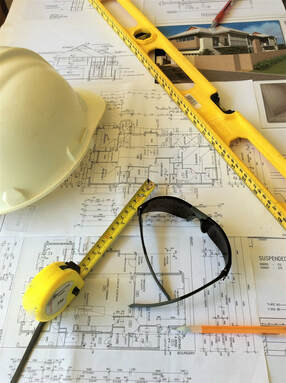 How hard can it be to choose a paint colour? It seems easy to pick a colour, until you see the hundreds of colours available. There are literally fifty shades of white and fifty shades of grey! Then you select your colour from a piece of paper, purchase the paint, put it on the walls and it looks totally different from the colour you selected. That’s because paint can look entirely different with different lighting conditions, and even by what it’s paired with – like the colour of carpets, furniture and fittings. Then we haven’t even mentioned the family arguments, with everyone picking a different shade of white. So employing an interior designer, or a colour specialist, to provide advice on paint colours can be money well spent, although it’s obviously not a necessity. Fortunately many paint suppliers can provide this expert at no cost, providing you use their products. But some attempt more extensive renovations and construction work themselves without a proper design. This comes with some risk. What are the risks of designing your home?There are a number of risks of designing your home without professional help. This includes:
Conclusion - saving money may make your new home more expensiveDesigners do cost money and we're all out trying to save money. But spending money on employing the right professionals will save you money. Importantly they will often guide you in the right direction - helping to crystallise your ideas onto paper. They will help prevent those family arguments over colours and finishes. They should simplify your choices. Proper design drawings are often a prerequisite for obtaining building approvals. Poor drawings could delay the process, even leading to the rejection of permit applications. See my article on Selecting a designer for more useful information.  For more valuable home design and renovation tips and advice read: 'An Introduction to Building and Renovating Houses - Volume 1 Hiring Contractors, Managing Construction and Finishing Your Home' and 'Volume 2 Finding Your Ideal Property and Designing Your Dream Home' This is an extract from: 'An Introduction to Building and Renovating Houses Volume 2' by Paul Netscher. Available in paper or eBook from Amazon.com, Amazon UK, Amazon CA, Amazon AU and all online bookstores. To read more © 2019 This article is not to be reproduced for commercial purposes without written permission from the author.
0 Comments
 Image courtesy of Sira Anamwong at FreeDigitalPhotos.net Image courtesy of Sira Anamwong at FreeDigitalPhotos.net When it comes to ceilings, whether it’s for your new home, renovation, or commercial space, there are many factors to consider, everything from your budget, the look, to the purpose of the ceiling – indeed, there’s more to the ceiling than being a cover over your head. Ceilings help insulate (both noise and temperature) the room below, they hide the structural elements of the house, they often conceal utility pipes and cables and they provide a decorative finish. In this article we examine the pros and cons of using drop-down ceilings in your home building project, also known as suspended ceilings, which are common in many commercial buildings and found in residences. In houses they are more typically used in basements because of their construction, cost and simplicity. These ceilings typically consist of a framework, normally metal tracks, which is suspended from the house structure using wires. Tiles or panels are then set or laid inside the tracks, forming the suspended ceiling. Types of tiles or panels The most common ceiling tile used in drop-down or suspended ceilings is the acoustic tile. These come in various colours and finishes and varying qualities. For an eye-catching look various colour tiles can even be combined. Some tiles can be more easily wiped clean – which is useful after the maintenance team has been working in the ceiling. In addition, there are other tile options such as:
Advantages of drop-down ceilings 1. Easy Installation – To install a drop-down ceiling, one needs to install metal tracks suspended by wires below the roof structure, then panels are laid or placed between the tracks – this is how the name “drop-down” or suspended ceiling came to be. Though it may seem simple to suspend the panels, installing the track work may require the assistance of a knowledgeable contractor. Many home owners intending to install the ceiling themselves can obtain the required knowledge from readouts and the internet, and they can purchase the materials from their local building supply stores. However, they need to maintain the safety of their home and ensure the ceiling won’t fall, while also ensuring that it’s aesthetically pleasing without sags when it’s finished. 2. Soundproofing – Drop-down ceilings can enhance the soundproofing of the room, either blocking noise from outside the house or from rooms above. Drop-down ceilings can be insulated with fibreglass, or similar products. 3. Concealing of wires, duct-work and imperfections – For the most part, drop-down ceilings are installed to hide wires, ducts and pipes, while providing easy access to the duct-work, wires and any other necessary building parts that require maintenance or check-ups. Similar to an access panel that provides easy and simple access to the ceiling space, drop-down ceilings do the same. . Disadvantages of drop-down ceilings 1. Loss of height and space – The biggest disadvantage of ceilings is that they reduce the height of a room by several inches (usually at least 8 to 12 but often more) to allow for the frame and wires. This could make the room appear smaller and the lower ceiling may interfere with the tops of windows, cupboards and furniture. 2. Quality – While drop downs are a cost-effective solution for a building, there are sometimes quality issues. They can over time deteriorate and change colours. This can be prevented with routine maintenance of the ceilings and panels and by ensuring there are no leaks leading to condensation or mould build-up. With time, poorly installed ceilings may sag. Frequent lifting of the panels to access the pipes and utilities in the ceiling space will lead to panels becoming damaged. 3. Not strong or sturdy – Generally the panels, framework and wires are lightweight. They can’t support heavy loads, such as a person’s weight, nor can they be used to support heavy light fittings or even ceiling fans, unless there’s additional support structures added. Conclusion – Weigh the Options Ceiling tiles can be eye-catching, and a properly installed drop-down ceiling could be a feature of the room. It’s often a practical low-cost solution for your ceiling requirements, hiding the services and utility pipes and cables in the ceiling void, while providing easy access to them for maintenance. Using different types of tiles can convey varying styles to your room. However, poor installation and using cheap products could result in your ceiling deteriorating with time. Care must also be taken that your drop-down ceiling doesn’t look like a commercial office ceiling. These ceilings aren’t as strong as traditional ceilings and can easily be damaged. Drop downs are a great choice for basic buildings and for practicality – just remember to ensure it meets all your building needs. So, if you are thinking of replacing your current ceiling, or planning on a remodeling project consider the various ceiling types and what will be best suited to your needs, budget and what will best suit your room and style choices. The is a guest article supplied by Access Doors and Panels - Your Access Door Super Store For more valuable tips and advice read: Build and Renovate Your Home With Your Eyes Wide Open.  You probably can’t wait to start building your new home, or renovating your current home. But, is this the right time? There is much to arrange and sort out before construction can begin. Considerations that may impact your home construction start
Planning permissions – is the red tape sorted?Most construction work requires planning permissions from the local authorities. Usually there’s a fee payable to get your building plans assessed. Unfortunately some authorities work slower than you expect. Verbal promises of when you can expect to receive the permissions are often broken. Then, when you finally get feedback it’s to say that there’s a problem which you have to fix before the permission can be granted. Invariably this delays the start of the project. Starting the project before permissions are received could result in work being stopped, even work having to be torn down, or monetary fines to pay. If you’re responsible for obtaining all the permissions ensure that these are submitted timeously, in the correct format and with all the required supporting documentation. Employing an expert could speed up the process and prevent mistakes which cause delays. Talk to the authorities and ensure that you thoroughly understand their requirements. Give them exactly what they want – even more. Continually stay in touch with them to see that the process stays on track, and that paperwork hasn’t been lost. Don’t give your contractor a start date, only to find that you haven’t received permissions by this date. Your contractor may charge you standing time waiting for the permits and permissions. Conclusion - ensuring everything is ready for home build projectWe all want to get our project started as soon as possible, but, it's important to check that everything is ready for construction so that the project isn't held up. Sometimes delaying the start of your building project may even make it cheaper. Carefully consider the best time to start your project.  For more valuable tips and advice read: 'An Introduction to Building and Renovating Houses - Volume 1 Hiring Contractors, Managing Construction and Finishing Your Home' and 'Volume 2 Finding Your Ideal Property and Designing Your Dream Home' This is an extract from: 'An Introduction to Building and Renovating Houses Volume 2' by Paul Netscher. Available in paper or eBook from Amazon.com, Amazon UK, Amazon CA, Amazon AU and all online bookstores. To read more © 2019 This article is not to be reproduced for commercial purposes without written permission from the author.  Image courtesy of TAW4 at FreeDigitalPhotos.net Image courtesy of TAW4 at FreeDigitalPhotos.net Many people only consider the actual costs of house construction, which we discussed in the article How much will your new house cost to build. But once the house is finished there are other costs to consider. These costs could make your new dream home unaffordable. It’s important to consider the ongoing costs of the house after the construction work is complete. Making the right decisions when designing your new home could reduce some of these costs. Running and ongoing costs after your house construction is finishedThe running or ongoing costs of your new house could include:
Conclusion - how you can lower the running costs of your new homeIt's important to consider the ongoing and running costs of your new house in conjunction with the costs to build or renovate your house. Sometimes spending a bit more during construction, perhaps selecting materials that don't require maintenance, or more hard wearing and durable finishes, could save money later. Fitting security features will reduce your insurance premiums. Installing solar panels and water recycling systems will reduce utility bills. Installing energy saving devises, passive heating and cooling systems, and even orientating the house correctly will reduce your energy and heating bills. But, sometimes the rates, insurance premiums and estate costs (levees) may just be too expensive. In this case you may have to consider building elsewhere where the rates are lower, or it may be necessary to build a smaller house, which is cheaper to build so the monthly loan repayments are less. A cheaper house also usually means lower rates and cheaper insurance premiums. Don't wait until you are living in your dream home to find that it's not affordable. Rather work out all the ongoing and running costs at the outset of your project, when you can still do something to reduce the bills.  For more valuable home construction and renovation tips and advice read: 'An Introduction to Building and Renovating Houses - Volume 1 Hiring Contractors, Managing Construction and Finishing Your Home' and 'Volume 2 Finding Your Ideal Property and Designing Your Dream Home' This is an extract from: 'An Introduction to Building and Renovating Houses Volume 2' by Paul Netscher. Available in paper or eBook from Amazon.com, Amazon UK, Amazon CA, Amazon AU and all online bookstores. To read more © 2019 This article is not to be reproduced for commercial purposes without written permission from the author. |
AuthorI’m a construction professional, author of several successful construction management books, and a home owner. I’ve made mistakes in construction management, I’ve seen others make mistakes, but importantly I’ve had multiple successful construction projects and I’ve learned from the mistakes. I want to share these lessons and my knowledge with you. Also available from:
Amazon Au, Amazon DE, Amazon ES, Amazon CA, Amazon IT, Amazon FR, Amazon NL, Amazon India and 'An Introduction to Building Houses - Volume 2 Finding Your Ideal Property and Designing Your Dream Home'
Archives
July 2024
CategoriesWe welcome genuine comments, especially comments that add additional information to the subject matter in the article. We however reserve the right to remove inappropriate comments, which includes comments that have nothing to do with the subject, comments that include inappropriate language, and comments that are an advertisement for a product or company, or which include an advertising link. Comments must be in English. We will not enter into discussion on why a particular comment was removed.
|


 RSS Feed
RSS Feed


